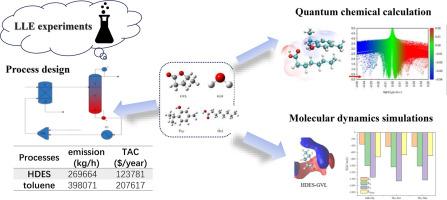Micro-mechanism and process study of green deep eutectic solvents in water/γ-valerolactone separation
IF 3.9
3区 工程技术
Q3 ENERGY & FUELS
Chemical Engineering and Processing - Process Intensification
Pub Date : 2025-08-19
DOI:10.1016/j.cep.2025.110516
引用次数: 0
Abstract
The current industrial production processes of γ-valerolactone (GVL) generate GVL-containing wastewater, which requires treatment to prevent environmental pollution and resource waste. In this paper, the overall performance of various organic solvents and hydrophobic deep eutectic solvents (HDESs) was evaluated based on the COSMO-SAC model. The extractants suitable for GVL/water separation were preliminarily screened. Quantum chemical calculations and molecular dynamics simulations analyzed the microscopic interaction mechanisms between HDESs and GVL aqueous solutions. Experimental validation further confirmed the separation effect of toluene and Thy-Oct as optimal extractants. The study used toluene and Thy-oct as the optimal organic extractants and optimal HDESs for the process design. It was optimized with the objective of the lowest total annual cost, accounting for the harmful gas emissions. The results showed that the total annual cost and harmful gas emission of the extraction-distillation separation process using Thy-Oct were reduced by 40.38 % and 32.26 %, respectively, compared with that using toluene, which verified the economic and environmental advantages of the extraction-distillation process with HDESs as the extractants, and provided a strong basis for the separation of the same kind of substances.

绿色深共晶溶剂在水/γ-戊内酯分离中的微观机理及工艺研究
目前γ-戊内酯(GVL)的工业生产过程产生含GVL的废水,需要对其进行处理,防止环境污染和资源浪费。本文基于cosmos - sac模型对各种有机溶剂和疏水深共晶溶剂(hess)的综合性能进行了评价。初步筛选了适用于GVL/水分离的萃取剂。量子化学计算和分子动力学模拟分析了hess与GVL水溶液的微观相互作用机理。实验验证进一步证实了最佳萃取剂甲苯和三聚氰胺的分离效果。本研究以甲苯和正己烷为最佳有机萃取剂和最佳hess进行工艺设计。在考虑有害气体排放的情况下,以年总成本最低为目标进行优化。结果表明,与甲苯相比,采用邻苯二甲酸乙酯进行萃取-精馏分离的年总成本和有害气体排放量分别降低了40.38%和32.26%,验证了以hess为萃取剂的萃取-精馏工艺的经济和环境优势,为同类物质的分离提供了有力的依据。
本文章由计算机程序翻译,如有差异,请以英文原文为准。
求助全文
约1分钟内获得全文
求助全文
来源期刊
CiteScore
7.80
自引率
9.30%
发文量
408
审稿时长
49 days
期刊介绍:
Chemical Engineering and Processing: Process Intensification is intended for practicing researchers in industry and academia, working in the field of Process Engineering and related to the subject of Process Intensification.Articles published in the Journal demonstrate how novel discoveries, developments and theories in the field of Process Engineering and in particular Process Intensification may be used for analysis and design of innovative equipment and processing methods with substantially improved sustainability, efficiency and environmental performance.

 求助内容:
求助内容: 应助结果提醒方式:
应助结果提醒方式:


